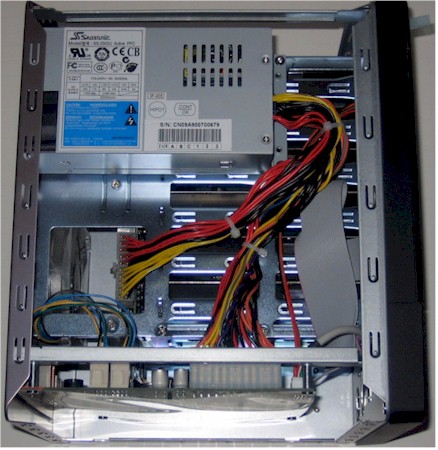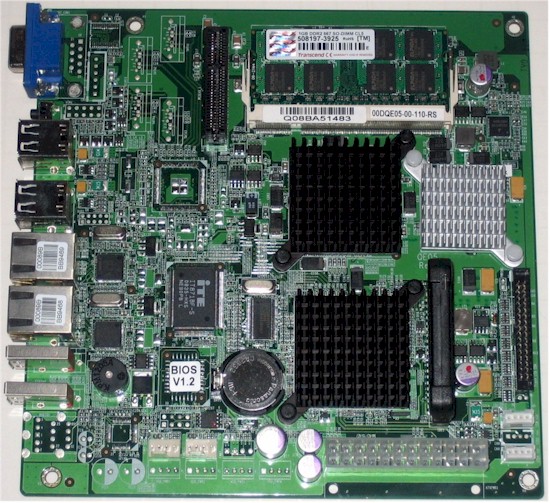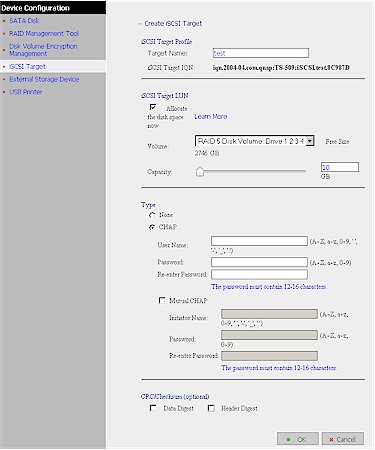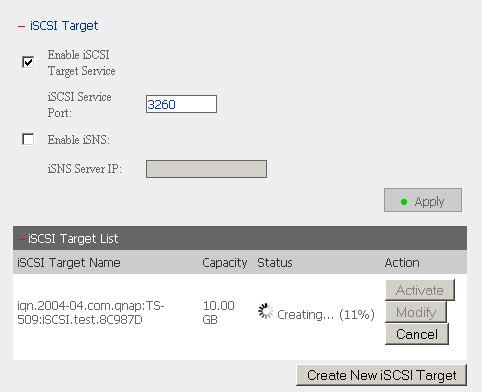Introduction
Updated 6/3/2009 Corrected SODIMM slot info.
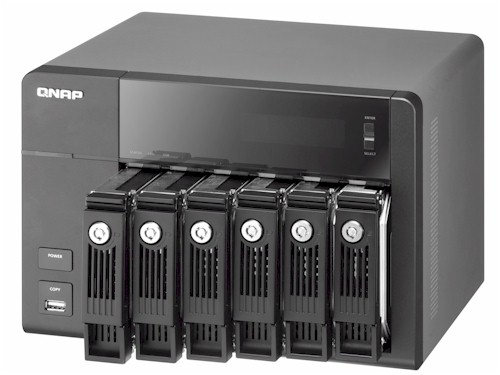
| At a Glance | |
|---|---|
| Product | QNAP Turbo NAS (TS-639 Pro) |
| Summary | Six-drive server-like Intel Atom-based BYOD NAS with support for single drives, JBOD and RAID 0, 1, 5, 5+ hot spare and 6. |
| Pros | • Online volume expansion and RAID migration • iSCSI target • Local console and remote SSH root access • Built-in LAMP server, DLNA multimedia server, FTP, iTunes • Fast attached backup to USB and eSATA drives |
| Cons | • Relatively expensive |
QNAP’s introduction of the TS-639 Pro has put many higher-end NAS buyers in a bit of a pickle. They are tempted by the additional disk and see that its Intel Atom-fueled performance can deliver almost 100 MB/s in our Vista SP1 File Copy test. But the five-drive TS-509 Pro has proven itself able to deliver throughput in the 80 MB/s range in real-world use and even more when teamed with a Gigabit switch supporting 802.3ad link aggregation and multiple sufficiently fast workstations.
Fortunately, QNAP finally sent the TS-509 Pro in for retesting with our new testbed when they sent the TS-639 Pro. So you’ll be able to finally do an apples-to-apples comparison using our NAS Chart data. The results, however, might not make your choice any easier!
Product Tour
The 639 Pro’s enclosure design opts for a bigger footprint on your desk than the 509 Pro by using a horizontal profile. I sorta liked the look, although it does take up more space. Figure 1 shows the front and rear panels and calls out key features.
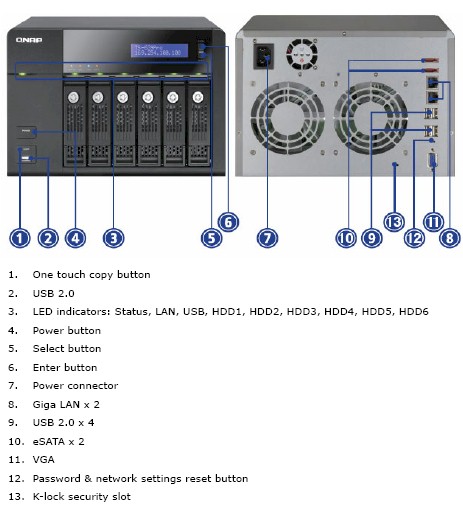
Figure 1: Front and Rear Panels
There is definitely a family resemblance between the 509 and 639 (I’ll omit the "Pro" until I hit the wrapup), with LCD status display, two-button navigation, and individually-lockable drive trays. The rear panels are cut from the same cloth, too, with dual Gigabit Ethernet ports that can be configured for failover or 802.3ad link aggregation, four of the five total USB 2.0 ports and a VGA connector that, along with a USB keyboard and mouse, provide console root access.
But there are differences, including the 639’s two eSATA ports vs. the 509’s one, no serial port on the 639 and no jumbo frame support on the 509. The 639’s horizontal format also forces the use of two smaller case fans vs. the 509’s one. But I didn’t notice a significant noise difference between the two. I will note that both products emitted annoying buzzes from time to time that quieted down after a gentle whack or two.
Internal Details
Figure 2 shows a view of the 639 from the top with the cover removed. The layout is clean with plenty of room. The power supply looks easy enough to replace, but you’ll need to remove the cover, then unscrew the back panel to replace the case fans. A more serviceable design would put the fans on a removable panel that didn’t require so much disassembly.
Figure 2: TS-639 Pro top inside view
There isn’t much to see in the left and right views, but click the links if you want to see them anyway.
The 639 uses an Intel N270 Atom clocked at 1.6 GHz. Figure 3 shows a shot of the board, which has the three key components covered with heatsinks. I’m guessing the CPU is under the smallest heatsink and the North and Southbridges are under the larger black heatsinks. From what I could decipher by logging in as root after attaching a display and USB keyboard, the Southbridge is an Intel 82801GBM ICH7-M.
Figure 3: QNAP TS-639 Pro main board
Updated 6/3/2009 Corrected SODIMM slot info.
There is one SODIMM slot holding 1 GB of DDRII 667 RAM. A generous 128 MB of flash comes in the form of an IDE DOM that you can see at the lower right.
That’s an ITE IT8718F "Super I/O" near the center and two Intel 82574L Gigabit Ethernet Controllers are near the two Ethernet jacks. Unlike the Broadcom BCM5787s used in the 509, the Intel controllers support up to 9K jumbo frames, which QNAP lets you set in 1000 Byte increments.
You don’t see any SATA controllers because the two Marvell 88SX7042 PCI-e 4-port SATA-II devices sit on the backplane that connects to the main board via the black connector to the left of the SODIMM.
QNAP is sticking with Ubuntu, as shown in the command output below (obtained via SSH login).
[~] # cat /proc/version
Linux version 2.6.24 (root@NasX86-3) (gcc version 4.1.3 20070929 (prerelease) (Ubuntu 4.1.2-16ubuntu2)) #1 SMP Wed Apr 8 03:37:09 CST 2009
The drives are formatted using the EXT3 filesystem, with no tweaks that could prevent drives from being removed and read by another EXT3-capable system.
Even with six Samsung HE103UJ 1 TB drives provided by QNAP with the review unit, the 639 uses less power than the 509: 73 W active and 34 W with drives spun down vs. 95 W / 52 W for the 509.
Features
Yup, you guessed it. I’m not going to spend a lot of time describing the 639’s feature set. See Craig Ellison’s TS-409 review and my more recent TS-119 review for backup details. Otherwise the getting-too-big-for-easy-comparison QNAP Feature Comparison Chart is the best place to match up the 639’s feature set against your shopping checklist.
Here is my handy-dandy summary for quick reference:
- Single disk, JBOD, RAID 0, 1, 5, 5+spare, 6 volumes
- RAID Expansion for all volume types
- RAID Migration: single drive to RAID 1, 5, or 6; RAID 1 to RAID 5 or 6; RAID 5 to RAID 6
- Accepts 1.5 and 2 TB qualified drives
- Network file sharing via SMB/CIFS, NFS, AFP
- FTP and secure FTP with bandwidth control
- HTTP / HTTPs file access
- Joins NT Domain / Active Directories for account information
- Attached Backup: Immediate or scheduled supporting FAT32, EXT3, NTFS drive formats (built-in formatter)
- Network Backup: Immediate or scheduled via rsync w/ encryption and compression options
- Client Backup: QNAP Netbak replicator (Windows only)
- iSCSI target support
- User quotas
- Email alerts
- Logging
- USB print server
- UPS shutdown synchronization
- LAMP webserving with MySQL, SQLite databases, phpMyAdmin, Joomla
- Root access via SSH and Telnet
- Media servers: UPnP AV / DLNA (TwonkyMedia), iTunes
- Web photo album
- BitTorrent / HTTP / FTP download service w/ scheduling
- IP camera recording and playback (four cameras)
In Use
The 639 hasn’t yet received the new AJAX-based admin GUI, so you’ll have to put up the the serviceable, but homely old one for awhile longer. Check out QNAP’s short video if you want to see what the new interface looks like. To me, it looks very similar to Synology’s interface.
I didn’t cover the iSCSI target features when I looked at the TS-119, so I’ll do it this time. Like the Thecus N7700, the 639 and other QNAPs that support iSCSI let you create multiple iSCSI targets (8 maximum) by allocating space on a volume. As Figure 4 shows, each target can be open or authenticate via CHAP.
Figure 4: Setting up an iSCSI target
Figure 5 shows the iSCSI Target summary, which I caught in in the middle of creating a target. Connecting to the iSCSI targets is easy with Windows. If you don’t know how, try following what I did. I’ll cover iSCSI throughput in the next section.
Figure 5: iSCSI target creation in progress
Performance
The 639 was tested with our standard test process. I upgraded to the latest 2.1.5 Build 0408T and used the Samsung HE103UJ 1 TB drives installed by QNAP. Tests were run with four drives configured in RAID 0 and 5 with 1000 Mbps and 1000 Mbps with 4k jumbo LAN connections.
Backup
I first checked backup performance to an Iomega UltraMax Pro Desktop Hard Drive configured in RAID 0 attached via both USB 2.0 and eSATA. The test copies a 4.35 GB ripped DVD test folder that I use in the NAS Chart Vista SP1 file copy tests from the NAS to the attached drive.
The results summarized in Table 1 show best performance, almost 69 MB/s, with EXT3 format and an eSATA connection—no big surprise. But the fact that the 639 Pro’s EXT3 / eSATA backup was faster than the TS-509 Pro’s at 53.78 MB/s is a bit surprising. By the way, the 509’s same result for FAT32 and EXT3 with eSATA isn’t a mistake. That’s what the tests yielded.
| Product | QNAP TS-639 Pro Backup Throughput (MBytes/s) |
QNAP TS-509 Pro Backup Throughput (MBytes/s) |
|---|---|---|
| USB – FAT32 | 18.76 | 19.16 |
| USB – EXT3 | 20.86 | 24.13 |
| USB – NTFS | 11.00 | 21.26 |
| eSATA – FAT32 | 48.00 | 53.78 |
| eSATA – EXT3 | 68.68 | 53.78 |
| eSATA – NTFS | 10.50 | 23.62 |
Table 1: Attached backup throughput test summary
I was also able to test the QNAP Remote Replication feature for NAS-to-NAS backup. Table 2 summarizes the results, for full backups of the test folder without and with the encryption option (SSH connection) enabled. The two products look pretty evenly matched. But I’m suspecting that the TS-639 Pro is the limiting factor between the two.
| Product | QNAP TS-639 Pro Backup Throughput to QNAP TS-509 Pro target (MBytes/s) |
QNAP TS-509 Pro Backup Throughput to QNAP TS-639 Pro target (MBytes/s) |
|---|---|---|
| NAS-NAS | 33.07 | 27.22 |
| NAS-NAS (SSH encrypted) |
10.55 | 9.62 |
Table 2: Networked backup throughput test summary
Benchmarks
Figure 6 presents a summary of the benchmark tests run for the 639 with RAID 0 and 5 write and read plotted. Performance boost at the smaller file sizes isn’t extreme for either RAID 0 or 5 writes and read performance is pretty flat across all file sizes tested.
Note: I didn’t plot jumbo frame results, because my test setup consistently shows lower performance when 4K jumbo frames are used. Some of the postings in the forums report similar experiences when using jumbo frames with high performance NASes and computers. So I may discontinue running the jumbo frame tests sometime soon.
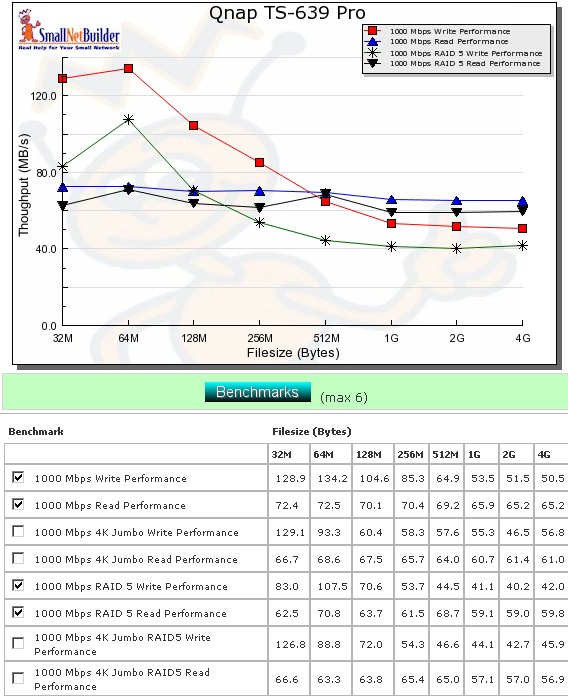
Figure 6: Performance benchmark summary
RAID 0 Performance with a 1000 Mbps LAN connection averaged over the 32 MB to 4 GB file sizes and with cached results above 125 MB/s removed from the average comes in at 68.5 MB/s for writes and 68.9 MB/s for reads. RAID 5 results were 60.3 MB/s for writes and 63.1 MB/s for reads. All results ranked the 639 in the top 5 in each chart.
Performance – Competitive
The candidates for competitive comparison were pretty obvious: the NETGEAR ReadyNAS Pro, Thecus N7700 and retested QNAP TS-509 Pro. The results were surprising!
Figure 7 shows the RAID 0 write results. The two QNAP and Thecus products are remarkably closely matched and only the NETGEAR distances itself from the pack, helped along mostly by its unusually high cached performance. But even when cache effects drop out, the ReadyNAS still doesn’t join the pack until the 2 and 4 GB file sizes. Note that the ReadyNAS was tested with three drives configured in RAID 0, while the other products were all tested with four.
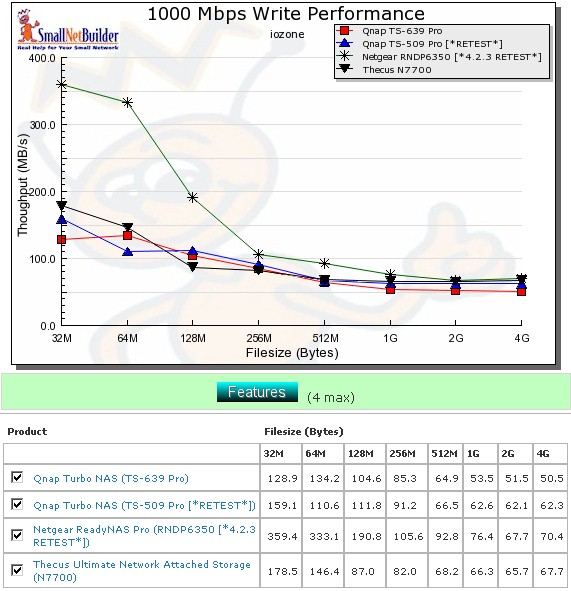
Figure 7: Competitive RAID 0 write comparison – 1000 Mbps LAN
Figure 8 compares the RAID 0 read performance, where it’s harder to determine the ranking. It’s safe to say that the 639 consistenly shows the lowest speed. But both the NETGEAR and Thecus drop off significantly above the 512 MB file size. On the other hand, the TS-509 Pro holds its own with the NETGEAR and Thecus at lower file sizes and maintains its high throughput at higher file sizes while the other two drop off.
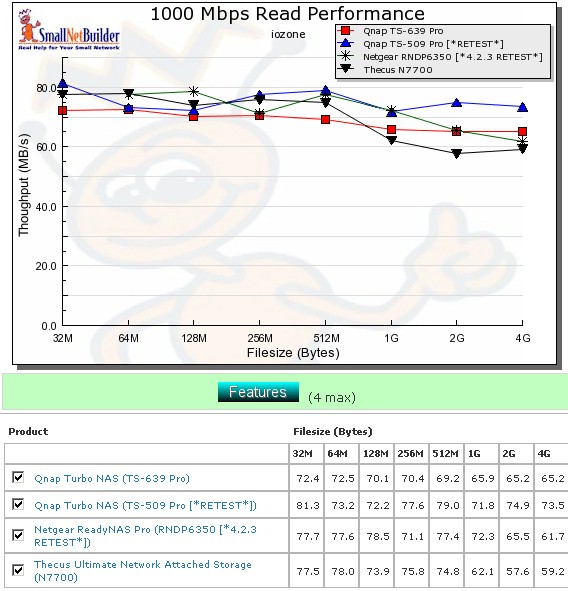
Figure 8: Competitive RAID 0 read comparison – 1000 Mbps LAN
For RAID 5 write (Figure 9), the NETGEAR again starts out with a high cache boost. But it soon falls below the Thecus, which maintains the highest throughput except for the 4 GB file size. The TS-639 again turns in the consistenly lowest performance of the group, beat out by the Thecus and TS-509 Pro.
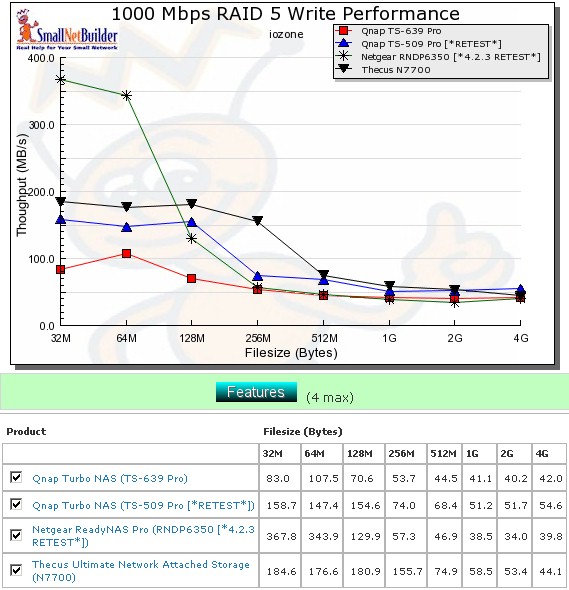
Figure 9: Competitive RAID 5 write comparison – 1000 Mbps LAN
For RAID 5 read, the TS-509 Pro handily beats the other products across all file sizes. The 639 again shows consistent performance, which beats out both the Thecus and NETGEAR at some file sizes.
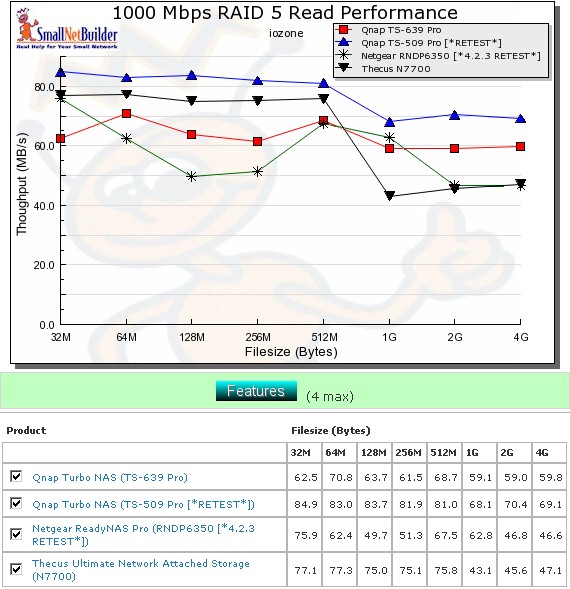
Figure 10: Competitive RAID 5 read comparison – 1000 Mbps LAN
At least by the iozone benchmark measure, the TS-509 Pro consistently beats the TS-639 Pro.
Performance – File Copy
Vista SP1 1000 Mbps RAID 5 file copy write results in Figure 11 show the 639 in fourth place behind the Thecus, 509 Pro and ReadyNAS Pro.
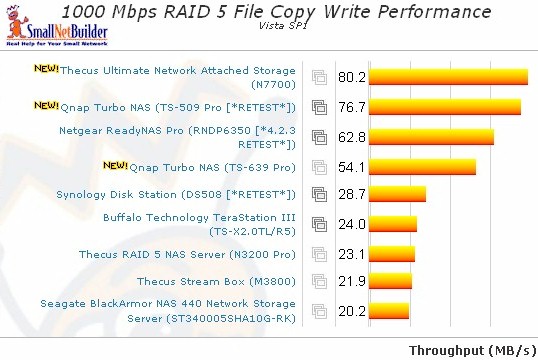
Figure 11: 1000 Mbps LAN Vista SP1 File Copy Write
Figure 12 shows the 1000 Mbps RAID 5 File Copy read. This time the 639 Pro beats out the Thecus N7700. But the TS-509 Pro still outperforms the 639 Pro.
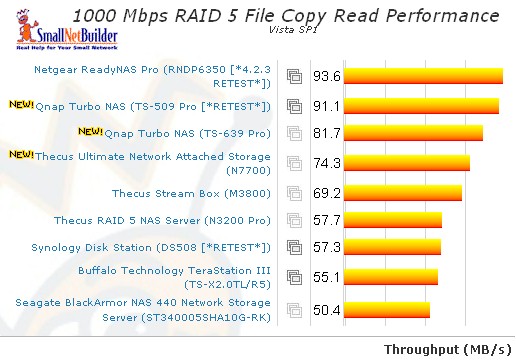
Figure 12: 1000 Mbps LAN Vista SP1 File Copy Read
Use the NAS Charts to further explore performance.
iSCSI
To test iSCSI performance, I set up a four-drive RAID 5 array on the 639 and allocated 10 GB of it as an iSCSI target. I then configured the Windows iSCSI initiator on the NAS Testbed machine to connect to the 639 and ran my standard Vista SP1 filecopy test. Both machines connected via Gigabit Ethernet with no jumbo frames used. I measured 53.7 MB/s for write and 85.5 MB/s for read.
I also ran the tests on a TS-509 Pro iSCSI volume and got 57.6 MB/s for write and 86.5 MB/s for read.
HD Tune Pro write benchmark plot in Figure 13 shows speed in MBytes per second, plotted across all sectors of the array. The average speed of 25.3 MB/s is significantly slower than the Vista SP1 filecopy test result. The same test run on the TS-509 Pro averaged a slightly higher 29.8 MB/s with a very similar-looking plot.
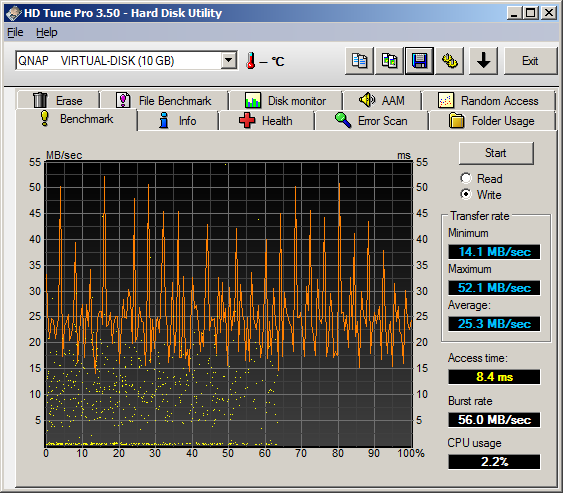
Figure 13: HD Tune Pro Benchmark Write Test
The HDTune Pro Benchmark read results are shown in Figure 14. The average this time is 54.4 MB/s, still below the Vista SP1 filecopy results. The same test run on the TS-509 Pro averaged a significantly higher 63.6 MB/s with a very similar-looking plot, but shifted upward.
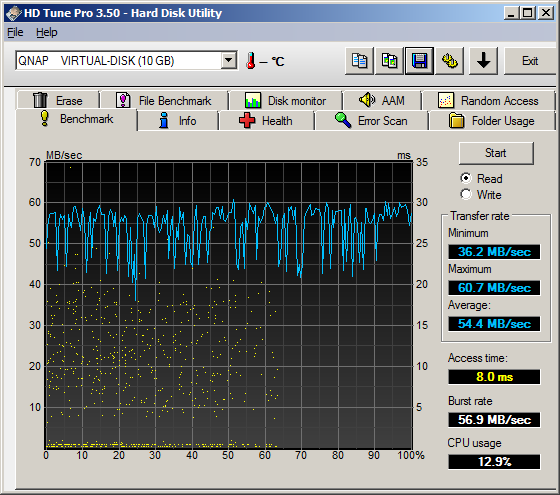
Figure 14: HD Tune Pro Benchmark Read Test
The HDTune File Benchmark test in Figure 15 writes and reads a test file of selectable size (I used the maximum 512 MB) using block sizes ranging from 0.5 KB to 8192 KB (x-axis). If we concentrate on the typically-used 64 KB block size, we can eyeball around 55 MB/s for write and read. For the TS-509 Pro, both read and write were just shy of 75 MB/s.
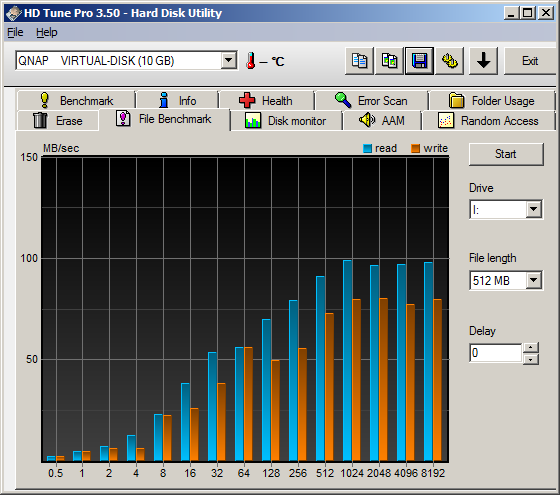
Figure 18: HD Tune Pro File Benchmark Read Write Test
Closing Thoughts
There has been a lot of speculation as to whether Intel’s Atom would enable a new class of low-cost, but high-powered NASes. My tests show that, at least in the form of QNAP’s TS-639 Pro, the Atom can deliver mid-50 MB/s RAID 5 writes and low 80 MB/s RAID 5 reads—not too shabby by any measure.
But the tests also show that, for highest performance, NAS makers are opting for more powerful Intel Celeron M and E2160 Dual Core CPUs.
All things considered, the TS-639 Pro is a powerful, full-featured NAS, no matter what CPU it uses. But if you don’t need the extra drive, QNAP’s TS-509 Pro will provide slightly more performance and save you $100 to $200, depending on how good a shopper you are.

